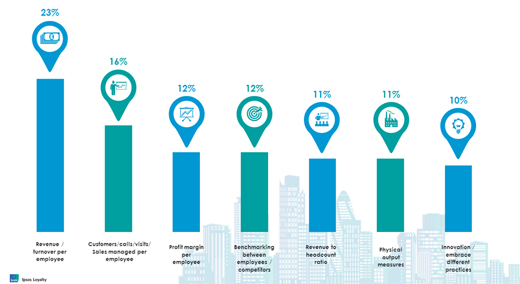The riddle of productivity: How can business leaders improve it when they can't agree on what it means?

Productivity in Britain is an enduring concern for politicians, policy-makers and commentators.
We hear time and time again how Britain is not performing well enough and exhortations to improve productivity1,2,3,4. And new figures published by the Office of National Statistics just last week showed the biggest productivity gap with other leading western economies since modern records began in the early 1990s.
The urgency to address the productivity problem is clear, therefore, but less so is what it means in practical terms for Britain’s businesses leaders. How do they measure productivity and what does this imply for how to improve it?
Ipsos’s annual Captains of Industry survey — now in its 35th year — seeks the views of the most senior people in top UK companies on the pressing issues of the day. In our most recent iteration of the survey we asked how they would define productivity for businesses like theirs (in their own words) and how they manage, measure and ultimately, look to improve productivity. This reveals a real diversity of opinion, demonstrating the different priorities and means of measuring productivity for business leaders in different industries. The common definitions fall into the following camps:

- Revenue or sales: The most frequently mentioned type of definition is in terms of sales, revenue, turnover or billable hours or “just how much money is our business bringing in?” About a quarter (23%) of senior business figures think of productivity in this way and this is the most common description from both industrial and service-based large companies:
“We look at our number of sales people; we look at the amount of revenue generated per head” "In retail it would be sales per member of shop staff” “For us it is fees per consultant on a four week basis, fees per employee”
- Customer numbers: The next most frequent type of description relates to customers (16%) and how many customer calls, visits and sales are conducted per employee per hour or per day. Often this is explicitly linked with the employee time or costs involved:
“It is the ratio of man hours per assignment” “(it) would be number of visits a day, percentage of visits that result in sales and a whole lot of other measures for our field force.”“It would be about increasing the number of customers, about increasing the number of products we sell to each customer and increasing the revenues we generate per employee”
- Profits: Revenue is important but only 12% of business leaders go on to clearly define productivity in terms of profit; mentioning profit margins, profit per employee, or improving the profit to loss ratio. Service providers in particular are more likely to mention profits than industrial firms:
“Our productivity would be measured by our cash margin profit per front line office employee…really profitability per employee would be our key measure”“Ultimately it comes down to the profits per employee. We measure this by checking the outputs on a monthly basis”
- Comparisons and benchmarking: Even if business decision makers are not quite clear exactly what the best measure of productivity is, comparisons over time or between units of their business can help them identify when it seems to be getting better (or worse) and which parts of the business seem to be more productive. Again about 1 in 8 (12%) mention the importance of comparisons or bench-marking in monitoring their businesses efficiency:
"Revenue and cross-sell revenue per person. We measure it on a weekly and monthly basis and we will principally focus on the highest performing 10% and the lowest performing 10%” “We benchmark globally. We know how many people it takes to run our units or we benchmark that against units across the world."
- Employee costs: Staff wages are mentioned as a factor by 11% in this survey - e.g. what is the wage bill per customer, the revenue to headcount ratio, or how to control wage costs or employee numbers. Since staff costs are often the largest cost for many businesses, it might have been expected more would mention this as a concern. However, the size and stability of their businesses may be a factor here. It would be interesting to compare the views of leaders of SMEs with the results from the large businesses covered in this survey:
“We seek to grow customer account and profit faster than the number of employees, year after year, so both are targeted and the number of employees always grows more slowly than the number of customers”
- Physical outputs: With service providers dominating the UK’s largest businesses, only 11% overall mention some sort of physical output as a measure of productivity, e.g. factory outputs/deliverables, units built, costs per unit. However, this is the second most common theme among the industrial/product based businesses:
“At factory level it tends to be more measured and you can measure it, at back office level you would improve productivity by doing the same thing with less people”
- Time/speed: “Time is money” but only 8% specifically mention the speed or time taken per task or transaction, or some other variant of time management.This seems to be a greater unprompted concern to the service sector, where extra time taken especially adds to employee costs, more so perhaps than among industrial businesses which also have materials, equipment purchase, maintenance, energy and other running costs to consider:
"The time that our people are spending working for our customers, as opposed to the cost of that time...We can certainly measure it and the main steps are around skills and then time management, managing downtime and travel and absenteeism.”
These results are just a glimpse at the ways leaders of large UK businesses think and talk about productivity, but they suggest that part of the challenge of increasing productivity is deciding what is the most useful way of defining it for a particular business, and how will success be measured.
Business leaders need to be clear their productivity measures are accurate, relevant to the main activity of the business that drives its profits, and are things that can be acted upon and so drive improvement.
- "UK’s poor productivity figures show challenge for the government” The Guardian, 18 September 2015
- “British Productivity is a national disgrace” The Daily Telegraph, 6March 2015
- "Russell Lynch: Up to George Osborne, not Mark Carney, to deliver goods on productivity” Evening Standard, 4February 2016
- "More trouble for George Osborne as MPs attack ‘useless’ productivity plan” Independent, 1February 2016
Technical Note:
Ipsos conducted 102 interviews with respondents (Chairmen, CEOs, MDs/COOs, Financial Directors and other executive board members) from the top 500 companies by turnover and top 100 by capital employed in the UK. Interviews were carried out face to face (just 5 were carried out by telephone) between 7th September and 9th December 2015. Quotations in this article are taken verbatim from respondents’ answers.



